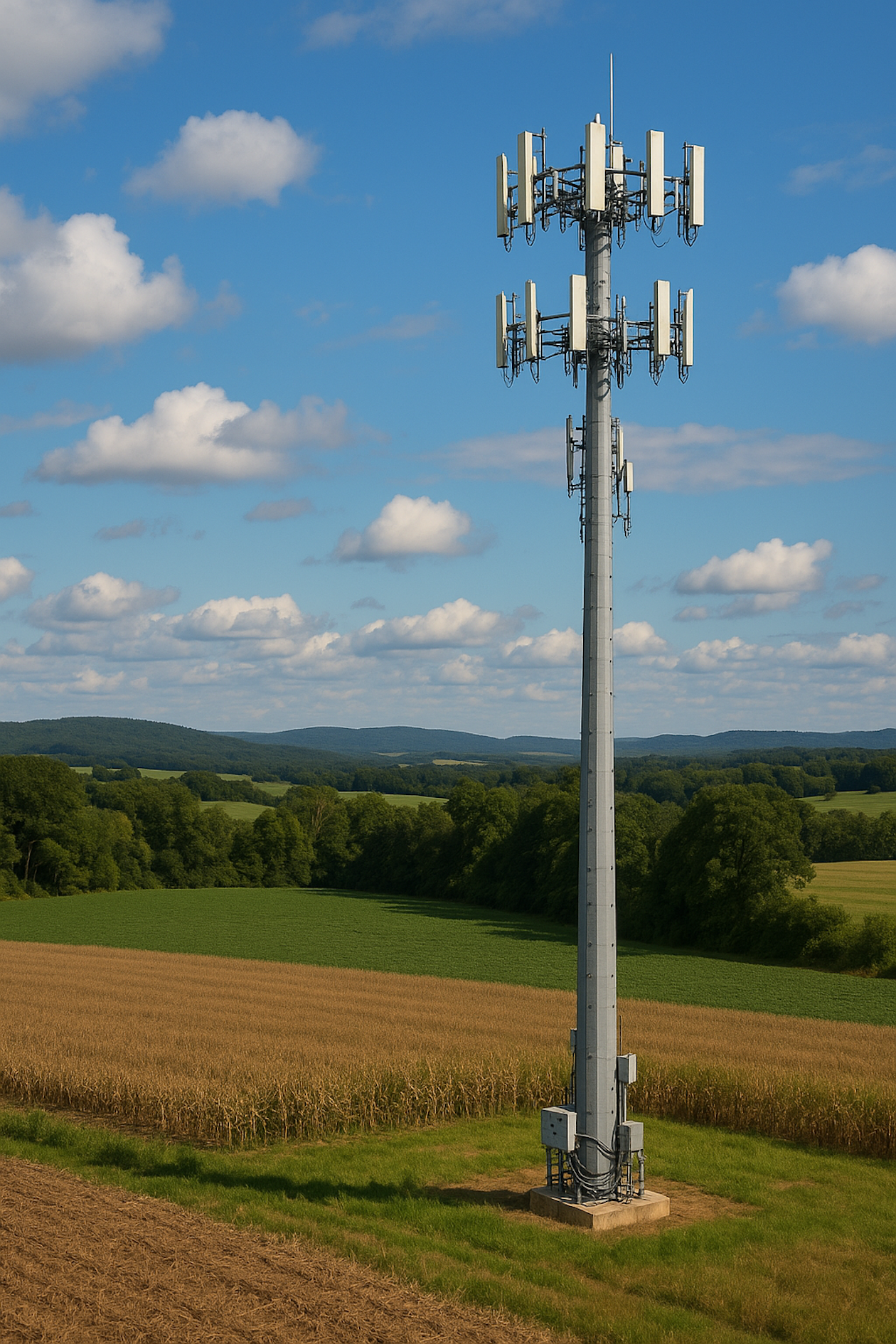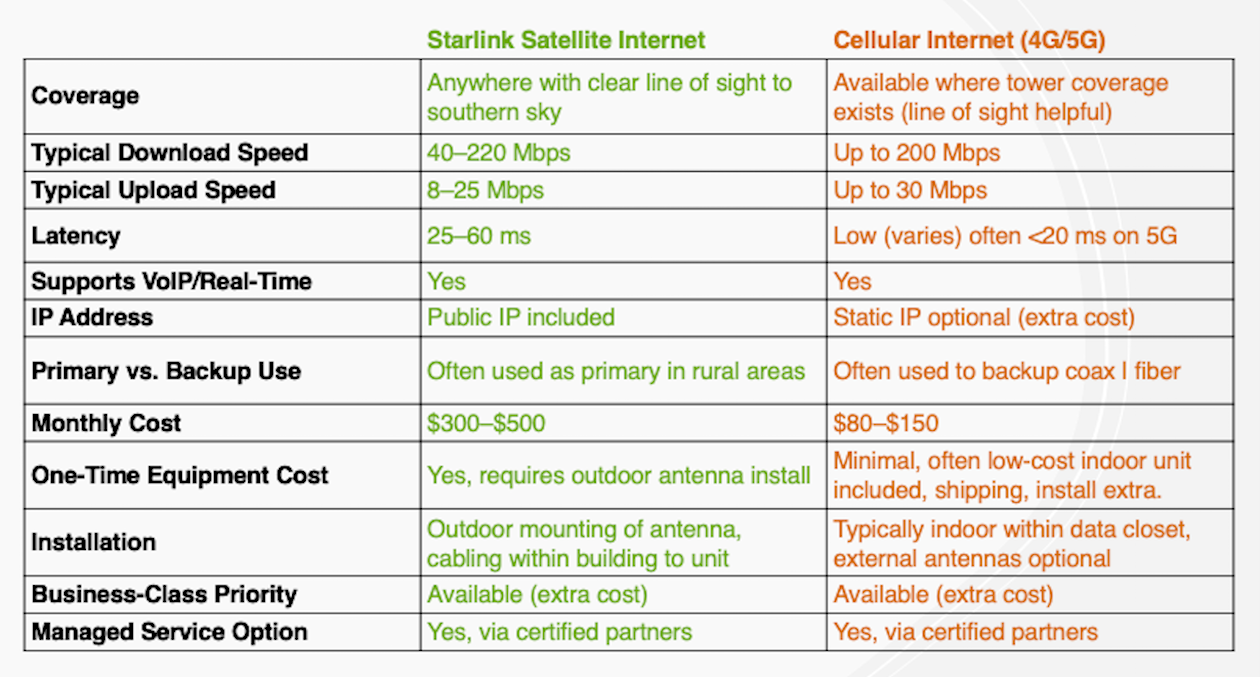As organizations become increasingly dependent on reliable, high-speed internet to run daily operations, the importance of having the right connectivity solution can’t be overstated. Businesses are looking beyond traditional cable and fiber connections to wireless options like Starlink satellite internet and cellular internet (4G | 5G) — whether as a primary service in remote areas or as a backup to their terrestrial network.
This article breaks down the strengths, limitations, and use cases for both Starlink and cellular internet, exploring the different roles in how each can be used for servicing your network, and offers guidance on which might be the best fit for your organization.
About Starlink
Coverage and Availability
Starlink, SpaceX’s satellite-based internet service, is available anywhere with a clear line of sight to the southern sky. This expansive coverage makes it a compelling choice for rural and underserved organizations in central Pennsylvania where terrestrial and cellular options are limited.
Performance
Starlink offers asynchronous data speeds ranging from 40–220 Mbps download and 8–25 Mbps upload, along with a public IP address. Latency typically falls between 25–60 milliseconds, which is low enough to support VoIP and other real-time applications without noticeable lag.
Data Plans and Service Options
Starlink’s flexible data plans can be tailored for different scenarios, whether as a primary internet connection or as a backup link. In practice, Starlink is more often deployed as a primary connection in areas without other viable options.
For business needs, the Business Class Priority Plan is worth serious consideration. With this plan, your connection gets priority on the network, ensuring more consistent speeds even during high-demand periods.
Budgeting for Starlink
Expect monthly costs for Starlink business service ranging from $300–$500, though the exact price depends on:
- Data requirements for your use case
- Whether the service is primary or backup
- Choice of priority plan for higher throughput
- Additional recurring fees if offered as a managed service by an authorized partner.
And, there’s a one-time equipment and installation cost, which can be significant due to the outdoor installation requirements of the antenna.
About Cellular (4G | 5G) Internet
Coverage and Availability
Cellular internet uses 4G | 5G networks to deliver connectivity, with performance dependent on proximity and line of sight to the nearest tower. When conditions are optimal, cellular service can deliver impressive speeds.
Performance
With strong tower coverage and line of sight, cellular internet can achieve 200 Mbps download and 30 Mbps upload speeds. While latency is already low on 4G and even lower on 5G, performance will still vary depending on network congestion and environmental factors. Static IP addresses are available from many carriers for an additional charge.
Data Plans and Service Options
Cellular internet supports VoIP and other real-time traffic with minimal latency and packet loss. Carriers may offer:
Tiered or pooled data plans for managing costs, as well as unlimited data plans
Business-class service levels
Pricing typically falls between $80–$150 per month, though, as with Starlink, final costs will depend on:
- Data plan size
- Priority service selection
- Equipment purchases or leases
- Optional managed services from certified partners
In most deployments, cellular is used as a secondary backup connection to a wired (fiber | coax) service. However, some organizations with optimal conditions have successfully run the service as their primary connection.
Wireless as a Failover: Key Considerations
Both Starlink and cellular can function as part of a failover strategy to keep your network running during primary service outages. Here are some important points to keep in mind:
- Compare Carrier Pricing
Shop multiple carriers and request quotes for plans that match your anticipated data usage. Many will include equipment with an activated SIM card for cellular service. - Network Edge Appliance Behavior
If you’re using a cloud-managed network edge appliance such as Cisco Meraki or Fortinet, it will maintain “keep alive” messages across both primary and secondary connections. These pings consume small amounts of bandwidth, which could matter on a limited data plan — even when the wireless connection is idle. - Overage Costs vs. Downtime Costs
When on a limited data plan, failover events will result in overage charges. However, the cost of exceeding your plan is often far less than the cost of business downtime. - Post-Failover Behavior
When your network fails back to the primary connection after an outage, existing sessions on the wireless link remain active on that link until they end naturally. This gradual failback can lead to unexpectedly high wireless data usage after the primary service is restored.
A simple workaround: temporarily disable the wireless connection post-failover to force all traffic back to the primary.
Which Service Is Right for your Organization?
Choosing between Starlink and cellular comes down to coverage, performance requirements, and how you plan to deploy the connection.
When Cellular Makes More Sense
- Best Value in Coverage Areas: If your location has strong 4G | 5G coverage, cellular offers fast speeds for the price, with basic plans that offer value under Starlink’s cost.
- Indoor Equipment Setup: Cellular equipment typically resides in your network closet and requires no rooftop work, making installation simpler.
- Flexibility: External antennas can be deployed for better reception in challenging signal environments, though these cases often require engineering help from an authorized partner.
When Starlink Is the Better Option
- Broad Coverage in Rural Central Pennsylvania: In regions where cellular service is weak or non-existent, Starlink is often the only high-speed option available.
- Business-Class Priority Needs: Organizations that need consistent speeds during peak hours benefit from Starlink’s priority service tier.
- Willingness for Outdoor Installation: Starlink requires a mounted antenna with clear line of sight to the southern sky, plus cabling into the building — something to budget and plan for.
Installation and Support
Both services can be installed by authorized, certified partners, which is strongly recommended if your team lacks experience with the technology. Partner installation ensures correct setup, optimal performance, and support for ongoing troubleshooting.
When purchased as a managed service, the provider takes care of monitoring, maintenance, and upgrades — freeing your IT team to focus on other priorities.
Ready to Pick the Best Service for your Organization – Contact Morefield
In a perfect world, every business would have fast, affordable, and reliable fiber optic Internet service. In reality, many locations — especially across central Pennsylvania — require a different approach. Starlink and cellular internet are both viable solutions, each with unique strengths:
- Cellular is often more cost-effective where coverage exists and can be quickly deployed indoors with minimal disruption.
- Starlink provides unmatched reach in rural locations and can offer business-class priority for consistent speeds.
For most organizations, the decision isn’t “either/or” — it’s about how each technology fits into your layered connectivity strategy. Applying these services as a primary connection or as a failover can provide maximum uptime, ensuring your business remains connected even during unexpected outages.

